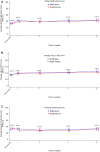Quality-of-life outcomes in metastatic spinal cord compression: findings from the SCORAD trial
- PMID: 38704149
- PMCID: PMC11223786
- DOI: 10.1093/jnci/djae039
Quality-of-life outcomes in metastatic spinal cord compression: findings from the SCORAD trial
Erratum in
-
Correction to: Quality-of-life outcomes in metastatic spinal cord compression: findings from the SCORAD trial.J Natl Cancer Inst. 2024 Aug 1;116(8):1408. doi: 10.1093/jnci/djae171. J Natl Cancer Inst. 2024. PMID: 39008828 Free PMC article. No abstract available.
Abstract
Purpose: This article reports detailed quality-of-life data including preferred and actual place of care from SCORAD, the only large prospective randomized trial in metastatic spinal cord compression (MSCC).
Methods: SCORAD compared 2 doses of radiotherapy in patients with MSCC: 8 Gy single fraction and 20 Gy in 5 fractions. In total, 686 patients were randomized, of whom 590 had Health-Related Quality of Life (HRQoL) data collected at baseline and at least 1 later time point. HRQoL was measured using the European Organisation for Research and Treatment of Cancer Quality of Life Questionnaire-Core 30 supplemented with the QLU-C10D and data on place of care at weeks 1, 4, 8, and 12 postrandomization. Quality-of-Life Adjusted Survival was computed by multiplying Kaplan-Meier survival probabilities with the UK utility weights obtained from the QLU-C10D.
Results: Patients with a baseline physical functioning score of above 50 demonstrated a 28% reduction in the risk of death (hazard ratio [HR] = 0.72, 99% confidence interval [CI] = 0.54 to 0.95; P = .003). An increased risk of death was associated with fatigue (HR = 1.35, 99% CI = 1.03 to 1.76; P = .0040), dyspnea (HR = 1.61, 99% CI = 1.24 to 2.08; P < .001), and appetite loss (HR = 1.25, 99% CI = 0.99 to 1.59; P = .014). The preferred place of care for the majority was at home or with relatives (61%-74% across the 12 weeks) but achieved by only 53% at 8 weeks.
Conclusions: Prolonged survival in patients with MSCC was associated with better HRQoL. More than 60% of patients preferred to be cared for at home or with relatives, but only half were able to achieve this. There was no difference in HRQoL between the multifraction and single-fraction groups.
Trial registration: ISRCTN97555949 and ISRCTN97108008.
© The Author(s) 2024. Published by Oxford University Press. All rights reserved. For permissions, please email: journals.permissions@oup.com.
Conflict of interest statement
The authors confirm that they have no conflicts of interest.
Figures
References
-
- Metastatic Spinal Cord Compression in Adults: Risk Assessment, Diagnosis and Management Clinical Guideline [CG75]. https://www.nice.org.uk/guidance/cg75/chapter/Introduction. Accessed February 3, 2024. - PubMed
-
- Loblaw DA, Mitera G, Ford M, Laperriere N. A 2011 updated systematic review and clinical practice guideline for the management of malignant extradural spinal cord compression. Int J Radiation Oncol Biol Phys. 2012;84(2):312-317. - PubMed
-
- Hoskin PJ, Hopkins K, Misra V, et al. Prognostic factors for survival and ambulatory status at 8 weeks with metastatic spinal cord compression in the SCORAD randomised trial. Radiother Oncol. 2022;173:77-83. - PubMed
Publication types
MeSH terms
Grants and funding
LinkOut - more resources
Full Text Sources



